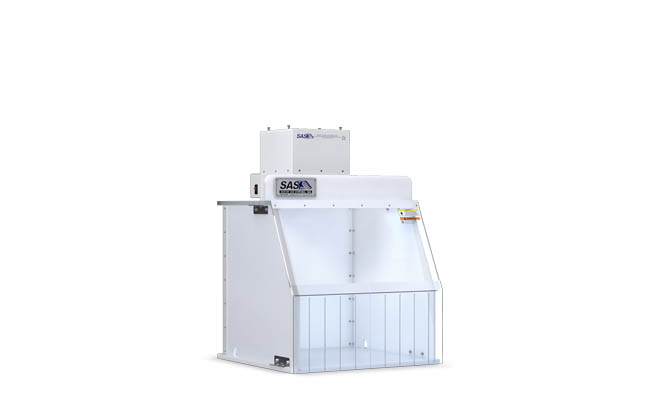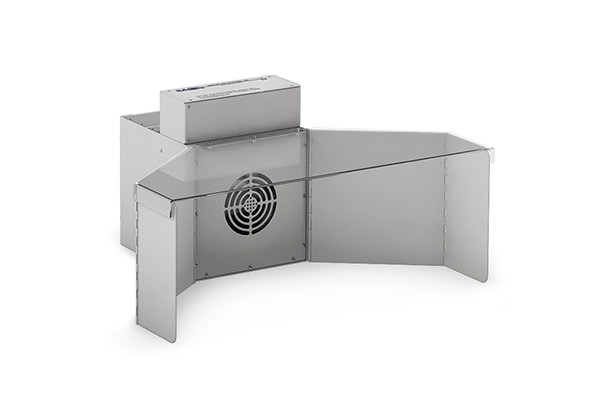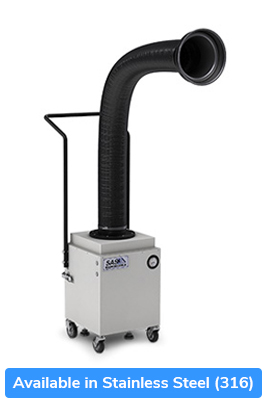Solvent Fume Extraction
Solvent fume extraction is a very distinct process that removes harmful fumes created from the evaporation of solvents after applicable use. Unfortunately, solvents evaporate very quickly, forming chemical fumes or vapors, which can easily be inhaled causing harmful side effects.
Many industrial processes utilize solvents to dissolve, dilute or remove unwanted residues. Common products that contain solvents include paints, inks, varnishes, cleaners, degreasers, glues, paint strippers, refrigerants, coolants, detergents, paint removers, and dry cleaning chemicals.
Workers in a wide variety of industries are exposed to solvents including:
- Engineering
- Construction
- Chemicals
- Printing
- Rubber
- Plastics
- Footwear
- Textiles
- Food
- Woodworking
- Dry Cleaning
- Manufacturing of paint, ink, and pharmaceuticals
To properly control solvent fumes, activated carbon filters adsorb chemical fumes removing them from the air. Adsorption works when the chemical reacts with the carbon sticking to the surface effectively removing it from the airflow. Activated carbon filters are treated to increase the surface area to improve adsorption. Portable fume extractors provide source capture solvent fume extraction to remove solvent fumes at the source before entering the operator’s breathing zone. These solvent fume extraction systems help prevent solvent fume symptoms and long term health hazards.

Ductless Hood
Ductless fume hoods, or filtered fume hoods, are self-contained, filtered enclosures that remove hazardous fumes, vapors and particulates from the immediate environment. Typically used in locations where outside ventilation cannot suffice, a ductless fume hood is a necessity to eliminate high percentages of harmful contaminants to protect users, applications and the atmosphere.
There are a few key characteristics that distinguish Ductless Fume Hoods from Conventional Ducted Fume Hoods (that typically vent outdoors):
- A “recirculating” air pattern and no external ducting or venting.
- The use of high-quality filtration media.
- Benefits including environmentally-friendly operation, energy efficiency, cost efficiency, minimal maintenance, and mobility.

Benchtop
The Winged Sentry is a compact benchtop air filtration system that provides a highly energy-efficient, quiet and economical solution to many fume extraction needs. It features adjustable "wing flaps" to assist in directing fumes towards the unit's inlet and into the filter chamber. The operator can place these wings in the most effective position for their particular application, or they can be positioned flat against the sides of the unit to conserve space.
Appropriate filtration media is installed in the Winged Sentry based on the application being performed by the operator. HEPA [up to 99.97% efficient on particles 0.3 microns and larger], ASHRAE [up to 95% efficient on particles 0.5 microns and larger], Activated Carbon, and specialty-blended media [i.e. Acid Gas, Mercury, Aldehyde, Ammonia] are the most common filters for this unit.

Portable
The Portable Floor Sentry fume extractor is a safety engineering control used for the capture and filtration of airborne contaminants. This source-capture fume extractor features heavy-duty casters for easy mobility, a flame-retardant and self-supportive flex arm, a small footprint, and high-quality filtration media.
Several filter media options are available for this unit and include: HEPA filtration [up to 99.97% efficient on particles 0.3 microns and larger, ASHRAE filtration [up to 95% efficient on particles 0.5 microns and larger], Activated Carbon, and specialty-blended filter media [i.e. Acid Gas, Mercury, Aldehyde, Ammonia]. The Portable Floor Sentry Fume Extractor allows multiple filter media to be housed inside the filter chamber for applications that emit both particulates and fumes.
Is Epoxy Toxic?
Yes, uncured epoxy is toxic, but once cured the epoxy is safe. Many epoxies contain solvent catalysts in the curing agents that can be highly toxic and corrosive. Two-component epoxies require the user to mix the epoxy resin with the curing agents involving a precise mix ratio to reduce health hazards. After mixing, the mixture contains a low catalyst concentration reducing the overall corrosive factor and toxicity.
Likewise, uncured epoxies prove more toxic during evaporation at higher temperatures in non-ventilated areas over long periods resulting in high air concentrations of epoxy fumes. Overexposure of epoxy fumes results in drowsiness, nausea, vomiting, or even loss of consciousness.
Overall because of the wide variety of epoxies available, users should review the epoxy’s safety data sheets in order to determine the toxicity and associated health hazards.
Epoxy Fume Extraction
Epoxy fume extraction removes harmful epoxy fumes released into the air after the application and before curing of the epoxy. When epoxies evaporate, hazardous vapors emit causing health problems upon inhalation and skin contact. Epoxies are comprised of one or two components. One-component epoxies utilize a heating element with an epoxy resin, then cured using heat from an oven. Two-component epoxies mix together epoxy resins with curing agents containing hardeners and sometimes catalysts to speed the curing process. Two-component epoxies can cure at room temperature or at elevated temperatures. Two-component epoxies are more widely used due to the ease of curing. Epoxies have a wide variety of uses due to the ability to adhere to many surfaces, resistance to chemicals and mechanical wear, liquid tightness, and fast curing ability.
Common epoxies can be used for:
- Adhesives
- Bonding
- Coatings
- Electrical Applications
- Flooring
- Marine Applications
- Paints
- Patching
- Priming
- Sealing
- Resurfacing
- Wood Repairs
Hazardous Solvents List
Hazardous solvents evaporate swiftly into the air producing harmful solvent vapors. a lighter and more quickly evaporated compound creates a more hazardous solvent fume. Many industrial solvents contain a combination of chemicals resulting in a synergetic effect. There are a wide variety of solvents and some of the most hazardous and commonly used include:
* - Efficiency Test Available
- Acetic Acid
- Acetone *
- Benzene
- Diethyl Ether *
- Ethanol
- Ethylbenzene
- Ethyl Acetate
- Glycol Ether Solvent *
- Hexanes
- Heptanes
- Isopropyl Alcohol *
- Isophorone
- Konform AR *
- Methanol
- Methyl Ethyl Ketone (MEK) *
- Methyl Isobutyl Ketone (MIBK)
- Methylene Chloride *
- Mineral Spirits
Epoxy Resin Health Hazards
Epoxy resin health hazards occur after inhalation or upon skin contact. Inhalation of epoxy fumes causes inflammation and irritation of the nose, throat, and lungs. An individual can become sensitized to epoxy exposure resulting in an allergic reaction upon additional exposure. Sensitization can occur at any time regardless of the concentration of exposure making exposure prevention vital at all times. Inhalation can also cause occupational asthma resulting in chest tightness, wheezing, and shortness of breath. Occupational asthma occurs when exposure to a workplace irritant causes or worsens asthma. According to Mayo Clinic, adhesive handlers and handlers or users of plastics and epoxy resins have a higher risk to develop occupational asthma than other occupations that do not handle epoxies.
Skin contact of epoxies may lead to allergic dermatitis causing irritated skin. The hardener component of epoxies can provoke hardener burns if skin contact occurs before mixing the epoxy. Hardener burns cause irritation, slight pain, and may discolor or scar the skin. Additionally, epoxy exposure has been shown to result in possible reproductive harm.
Resources
Protective air filtration for evidence storage facilities and the people who manage them
Reducing Hazardous Exposure to Organic Solvents
High-volume solvent application required large custom fume hood
Very large, custom containment hood designed to manage epoxy fumes
Testimonial: Epoxy and Adhesive Fume Control – Bulow Biotech Prosthetics
Epoxy Fume Hazards and Fume Control Solutions
Containment Hoods for Epoxy Overspray

 Made in the USA
Made in the USA